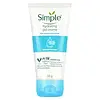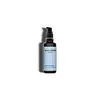What's inside
What's inside
 Key Ingredients
Key Ingredients

 Benefits
Benefits

 Concerns
Concerns

 Ingredients Side-by-side
Ingredients Side-by-side

Water
Skin ConditioningGlycerin
HumectantDimethicone
EmollientButylene Glycol
HumectantIsohexadecane
EmollientPropylene Glycol
HumectantAmmonium Acryloyldimethyltaurate/Vp Copolymer
Caprylic/Capric Triglyceride
MaskingPhenoxyethanol
PreservativeCaprylyl Glycol
EmollientTocopheryl Acetate
AntioxidantHydrogenated Poly(C6-14 Olefin)
EmollientAmmonium Acryloyldimethyltaurate/Beheneth-25 Methacrylate Crosspolymer
Emulsion StabilisingLinoleamidopropyl Pg-Dimonium Chloride Phosphate
Stearic Acid
CleansingSodium PCA
HumectantDisodium EDTA
BHT
AntioxidantSaccharide Isomerate
HumectantSodium Citrate
BufferingCitric Acid
BufferingPotassium Chloride
Sodium Chloride
MaskingWater, Glycerin, Dimethicone, Butylene Glycol, Isohexadecane, Propylene Glycol, Ammonium Acryloyldimethyltaurate/Vp Copolymer, Caprylic/Capric Triglyceride, Phenoxyethanol, Caprylyl Glycol, Tocopheryl Acetate, Hydrogenated Poly(C6-14 Olefin), Ammonium Acryloyldimethyltaurate/Beheneth-25 Methacrylate Crosspolymer, Linoleamidopropyl Pg-Dimonium Chloride Phosphate, Stearic Acid, Sodium PCA, Disodium EDTA, BHT, Saccharide Isomerate, Sodium Citrate, Citric Acid, Potassium Chloride, Sodium Chloride
Water
Skin ConditioningMaris Aqua
HumectantGlycerin
HumectantGlyceryl Stearate
EmollientPEG-100 Stearate
Caprylic/Capric Triglyceride
MaskingButyrospermum Parkii Butter
Skin ConditioningUndecane
EmollientXylitylglucoside
HumectantSodium Acrylate/Sodium Acryloyldimethyl Taurate Copolymer
Emulsion StabilisingMethyl Gluceth-20
HumectantTridecane
PerfumingAnhydroxylitol
HumectantPhenoxyethanol
PreservativeIsohexadecane
EmollientStearic Acid
CleansingPalmitic Acid
EmollientCaprylyl Glycol
EmollientXylitol
HumectantPolysorbate 80
EmulsifyingTocopheryl Acetate
AntioxidantEthylhexylglycerin
Skin ConditioningSorbitan Oleate
EmulsifyingAloe Barbadensis Leaf Juice Powder
Skin ConditioningGlucose
HumectantSilica
AbrasiveSodium Hydroxide
BufferingSodium Benzoate
MaskingPotassium Sorbate
PreservativeLactic Acid
BufferingTocopherol
AntioxidantHelianthus Annuus Seed Oil
EmollientCitric Acid
BufferingWater, Maris Aqua, Glycerin, Glyceryl Stearate, PEG-100 Stearate, Caprylic/Capric Triglyceride, Butyrospermum Parkii Butter, Undecane, Xylitylglucoside, Sodium Acrylate/Sodium Acryloyldimethyl Taurate Copolymer, Methyl Gluceth-20, Tridecane, Anhydroxylitol, Phenoxyethanol, Isohexadecane, Stearic Acid, Palmitic Acid, Caprylyl Glycol, Xylitol, Polysorbate 80, Tocopheryl Acetate, Ethylhexylglycerin, Sorbitan Oleate, Aloe Barbadensis Leaf Juice Powder, Glucose, Silica, Sodium Hydroxide, Sodium Benzoate, Potassium Sorbate, Lactic Acid, Tocopherol, Helianthus Annuus Seed Oil, Citric Acid
 Reviews
Reviews

Ingredients Explained
These ingredients are found in both products.
Ingredients higher up in an ingredient list are typically present in a larger amount.
This ingredient is an emollient, solvent, and texture enhancer. It is considered a skin-softener by helping the skin prevent moisture loss.
It helps thicken a product's formula and makes it easier to spread by dissolving clumping compounds.
Caprylic Triglyceride is made by combining glycerin with coconut oil, forming a clear liquid.
While there is an assumption Caprylic Triglyceride can clog pores due to it being derived from coconut oil, there is no research supporting this.
Learn more about Caprylic/Capric TriglycerideCaprylyl Glycol is a humectant and emollient, meaning it attracts and preserves moisture.
It is a common ingredient in many products, especially those designed to hydrate skin. The primary benefits are retaining moisture, skin softening, and promoting a healthy skin barrier.
Though Caprylyl Glycol is an alcohol derived from fatty acids, it is not the kind that can dry out skin.
This ingredient is also used as a preservative to extend the life of products. It has slight antimicrobial properties.
Learn more about Caprylyl GlycolCitric Acid is an alpha hydroxy acid (AHA) naturally found in citrus fruits like oranges, lemons, and limes.
Like other AHAs, citric acid can exfoliate skin by breaking down the bonds that hold dead skin cells together. This helps reveal smoother and brighter skin underneath.
However, this exfoliating effect only happens at high concentrations (20%) which can be hard to find in cosmetic products.
Due to this, citric acid is usually included in small amounts as a pH adjuster. This helps keep products slightly more acidic and compatible with skin's natural pH.
In skincare formulas, citric acid can:
While it can provide some skin benefits, research shows lactic acid and glycolic acid are generally more effective and less irritating exfoliants.
Most citric acid used in skincare today is made by fermenting sugars (usually from molasses). This synthetic version is identical to the natural citrus form but easier to stabilize and use in formulations.
Read more about some other popular AHA's here:
Learn more about Citric AcidGlycerin is already naturally found in your skin. It helps moisturize and protect your skin.
A study from 2016 found glycerin to be more effective as a humectant than AHAs and hyaluronic acid.
As a humectant, it helps the skin stay hydrated by pulling moisture to your skin. The low molecular weight of glycerin allows it to pull moisture into the deeper layers of your skin.
Hydrated skin improves your skin barrier; Your skin barrier helps protect against irritants and bacteria.
Glycerin has also been found to have antimicrobial and antiviral properties. Due to these properties, glycerin is often used in wound and burn treatments.
In cosmetics, glycerin is usually derived from plants such as soybean or palm. However, it can also be sourced from animals, such as tallow or animal fat.
This ingredient is organic, colorless, odorless, and non-toxic.
Glycerin is the name for this ingredient in American English. British English uses Glycerol/Glycerine.
Learn more about GlycerinIsohexadecane is added to enhance texture, emulsify, and to help cleanse. It is an isoparrafin. It is a component of petrolatum.
Due to its large size, Isohexadecane is not absorbed by the skin. Instead, it sits on top and acts as an emollient. Emollients help keep your skin soft and smooth by trapping moisture within.
Isohexadecane is often used in products designed to help oily skin. It is lightweight and non-greasy while helping to moisturize. When mixed with silicones, it gives a product a silky feel.
Learn more about IsohexadecanePhenoxyethanol is a preservative that has germicide, antimicrobial, and aromatic properties. Studies show that phenoxyethanol can prevent microbial growth. By itself, it has a scent that is similar to that of a rose.
It's often used in formulations along with Caprylyl Glycol to preserve the shelf life of products.
Stearic Acid is a fatty acid. It is an emollient, emulsifier, and texture enhancer.
As an emollient, stearic acid helps soften skin. It aids the skin's protective barrier by preventing water loss. It also provides a gentle cleansing effect without stripping away natural oils.
Stearic acid may also be used to enhance the texture of products. It can add volume and stabilize ingredients such as water and oil. This can help water and oil ingredients from separating.
Sources of stearic acid include animal or vegetable fats/oils such as coconut or shea. It can be naturally found in butter, cocoa butter, shea butter, vegetable fats, and animal tallow.
This ingredient may not be Malassezia folliculitis, or fungal-acne safe.
Learn more about Stearic AcidTocopheryl Acetate is AKA Vitamin E. It is an antioxidant and protects your skin from free radicals. Free radicals damage the skin by breaking down collagen.
One study found using Tocopheryl Acetate with Vitamin C decreased the number of sunburned cells.
Tocopheryl Acetate is commonly found in both skincare and dietary supplements.
Learn more about Tocopheryl AcetateWater. It's the most common cosmetic ingredient of all. You'll usually see it at the top of ingredient lists, meaning that it makes up the largest part of the product.
So why is it so popular? Water most often acts as a solvent - this means that it helps dissolve other ingredients into the formulation.
You'll also recognize water as that liquid we all need to stay alive. If you see this, drink a glass of water. Stay hydrated!
Learn more about Water